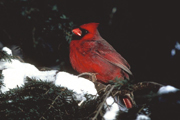Our Feathered Friends
Cope With the Cold
By Kathy Reshetiloff
It's still too early
in the morning. I sip my coffee, trying to decide just what I'll
need today to fend off the cold today: windbreaker, sweatshirt
or sweater. I decide on the sweatshirt and dash out the door to
warm up my pickup. A tiny bird catches my eye, a feisty chickadee,
as it hops along the branch of our dogwood tree. The frosty morning
air doesn't seem to bother this little bird at all.
 Birds have developed some remarkable adaptations in order to survive
cold and severe weather. Look outside on a blustery winter day
and you'll still see songbirds flitting around a feeder and ducks
swimming in an icy creek. Nearly one million waterfowl fly to
the Chesapeake region from northern breeding grounds each year.
They find that the winters here suit them just fine.
Birds have developed some remarkable adaptations in order to survive
cold and severe weather. Look outside on a blustery winter day
and you'll still see songbirds flitting around a feeder and ducks
swimming in an icy creek. Nearly one million waterfowl fly to
the Chesapeake region from northern breeding grounds each year.
They find that the winters here suit them just fine.
Many birds, of course, leave the Chesapeake to overwinter in warmer
areas. About 340 species of birds migrate to tropical regions
of Mexico, Central America, South America and the Caribbean.
But some birds remain here year round. How do they do it? Birds,
like mammals, are warm-blooded animals, meaning they must maintain
a constant body temperature as the temperature around them changes.
In order to do this, they spend much of their time feeding so
they can generate enough heat. It's a vicious cycle though; they
must eat to keep warm so they can gather more food. Birds that
can switch from an insect diet to a seed diet can stay put throughout
the winter. Some meat-eating birds, like hawks and owls, may also
remain if enough prey is available.
One of the obvious features that sets birds apart from other animals
is their feathers. Birds' bodies are covered with an outer layer
of fairly stiff but flexible contour feathers and an under layer
of fluffy down feathers. The contour feathers provide protection
against wind, rain and snow. The down feathers act as a layer
of insulation.
Tightly knit together and overlapping, feathers protect the skin
and hold a layer of air over the bird's body. Because birds control
the position of their feathers through muscular movements, they
are able to "puff" themselves up. By adjusting their feathers,
birds create and trap larger pockets of warm air near their skin,
enhancing insulation.
Most birds have an oil gland located at the base of their tail.
Secreted oil is rubbed over the feathers with the beak or bill.
This is known as preening. Preening conditions the feathers, creating
a shield that helps block wind and repel water. Birds like waterfowl
can survive in water that is close to freezing because the amount
of oil in their feathers makes them waterproof. Waterfowl and
other waterbirds also have a layer of fat that keeps them warm.
Anyone who has ever gone outside on a cold, windy day without
a hat knows that uncovered areas lose heat. The same is true for
birds. But they can adjust to this in several ways. Often birds
will stand on one leg, tucking the other up among their feathers.
Birds are also observed with their beaks tucked under their feathers.
Smaller birds often drop on the ground to cover both legs with
their fluffed up bodies.
To minimize heat loss from legs, arteries and veins in legs of
many birds lie in contact with each other and function to retain
heat. Arterial blood leaves a bird's core at body temperature
while venous blood in the feet is cool. Heat is conducted from
the warm arteries to the cool veins. Arterial blood reaching the
feet is already cool and venous blood reaching the core is already
warm.
Waterfowl have fleshy feet with little blood circulation so they
are less sensitive to cold. Constricting blood vessels reduces
the amount of blood flow to the feet at low temperatures. Thus
the core temperature of a duck or gull standing on ice may be
104 degrees Fahrenheit but the temperature of their feet may be
just above freezing.
All of this may seem of little importance as you bundle up in
multiple layers to face another wintry day. But just imagine how
dull the landscape would be without these hardy souls. Winter
songbirds, waterbirds and waterfowl are often the only wildlife
one sees at this time of year. As I scrape the frost off my windshield,
I'm envious of the many ways that these delicate animals are able
to adjust. Then I go back inside to look for my gloves.
Kathy Reshetiloff is employed by the U.S. Fish and Wildlife Service, U.S. Department of the Interior. Photo by Rich Mason, U.S. Fish and Wildlife Service.
|
Back
|

